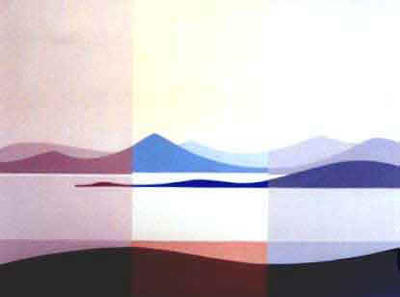[The Pioneer: April 8, 1998]
My first suggestion to the viewers is that they should not get stuck with the prevalence of triangles in his large acrylic paintings, thinking that it is yet another reification of the ‘Tantra Art’. Had it been so then Vishwanadhan’s casein paintings of horizontal segments stacked up in fascinating tropical colours would have remained alienated from the total body of his work, films, and graphics and etc. If we waive aside the ‘Tantra’ hangover, we will see that his triangles are one of the basic elements that makes squares, and a square and it half sprayed into a rectangle — the ‘Golden Section’ of the European Renaissance – and rectangles into further squares which, in India rituals and Tantric mandalas are kshetra or the space on earth. 
Vishwanadhan combines and recombines these basic geometrical abstractions of our traditional symbology of creation and existence into paintings after paintings, sometimes painted in concentric brushstrokes of vermillion, saffron, touches of sap green and all forms stacked up one layer over another, sometimes brushed off partially, sometimes painted in an austere range of greys and browns like the early Cubists.
The patient viewer will not miss the continuous pulsation of movements, both in terms of colour arrangement and linear directions, a changing and at the same time changeless continuum of the fabric of life. This we find in his intaglio prints with the minimum linear elements. One thing intrigues me, that is the dark ‘dots’ in them. They are to made up of raisin dust. Then comes his large combines of squares of sand of different colours—the squares or the kshetras that make rectangles which can multiply in area ad infinitum….
Pictorally they have the beauty of the physicist’s equation that carries the bewilderingly enormous range of findings in a few algebraic expressions balanced on either side... His stacked up colour horizontals sometimes overlap, sometimes leave some bright chinks or cracks of the white canvass and the small sources of pure white light change the bright tropical colours dawn in unhurried brushstrokes…

Vishwanadhan combines and recombines these basic geometrical abstractions of our traditional symbology of creation and existence into paintings after paintings, sometimes painted in concentric brushstrokes of vermillion, saffron, touches of sap green and all forms stacked up one layer over another, sometimes brushed off partially, sometimes painted in an austere range of greys and browns like the early Cubists.
The patient viewer will not miss the continuous pulsation of movements, both in terms of colour arrangement and linear directions, a changing and at the same time changeless continuum of the fabric of life. This we find in his intaglio prints with the minimum linear elements. One thing intrigues me, that is the dark ‘dots’ in them. They are to made up of raisin dust. Then comes his large combines of squares of sand of different colours—the squares or the kshetras that make rectangles which can multiply in area ad infinitum….
Pictorally they have the beauty of the physicist’s equation that carries the bewilderingly enormous range of findings in a few algebraic expressions balanced on either side... His stacked up colour horizontals sometimes overlap, sometimes leave some bright chinks or cracks of the white canvass and the small sources of pure white light change the bright tropical colours dawn in unhurried brushstrokes…
